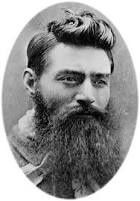Eaglemont Setting for Kelly Gang Film in 1905

The recent use of the Eaglemont Village as a setting for an ABC television series has revived mentions of a much earlier role for the district in the Australia's fledgling film industry.
What is believed to be the first "feature film" was shot around Eaglemont & Eltham based on "the Kelly gang", a saga that ended in the capture, trial and hanging of Ned Kelly.
It screened in 1905, just 25 years after the hanging of the outlaw Ned Kelly at Melbourne gaol.
No copies of the film survive.**
OUR FILM INDUSTRY
The Daily Telegraph (Sydney, NSW : 1931 - 1954), 09.11.1946, Page 16
"The Kelly Gang" was made by Messrs. Johnson and W. A. Gibson, of Melbourne, and the very young firm of J. and N. Tait.
W. A. Gibson, originally a chemist, with his partner, had spent £40 to buy a movie camera owned by a touring Englishman, and had gone into the movie business.
An old-time showman named Sam Crews suggested that the Taits make "The Kelly Gang" as a movie (the bushranging saga was then a smash stage show).
Johnson and Gibson provided the equipment, and took a share in the venture.
The picture was taken mostly at Eaglemont and at Chartersville estates, Heidelberg — and generally on Sundays. The company went out by train or "drag" (large waggonette), taking their picnic lunch with them.
Mr. Gibson operated the camera, and John Tait, Frank Tait, and Mrs. Charles Tait (she played Kate Kelly) were in the film.
Ned Kelly the star received £1 a day, and wore the genuine Kelly armor, borrowed from Sir Rupert Clarke.
The extras were recruited from tough citizenry, who turned the bar-room brawls into the real thing, and had to be separated by force.
The film's big highlight was the Kellys' final stand at Glenrowan, when the railway track was lifted by the gang. The Railways Commissioner placed a train and gangers at Eltham rail terminus for the occasion.
W. A. Gibson later calculated that "The Kelly Gang" cost £400 to film. It was first released at the Melbourne Athenaeum at Christmas, 1905, and was a hit.
Unhappily, the original negative was lost or destroyed, and there are no prints in existence. But copies of old magazine photographs show the Kellys with ferocious large felt hats, large gum-boots, and a beard or two, swaggering on a tiny, open-air stage.
The gully scenes in the bush are notable for lopped timbers, and a general air of goodwill.
Apart from beating America to multiple-reel films by some six years, "The Kelly Gang" had enormous influence in Australia. It began a whole cycle of bushranging pictures—and a New South Wales censorship storm that rumbles to this day.
Update on this story
** In 2007, The Story of the Kelly Gang was inscribed on the UNESCO Memory of the World Register for being the world's first full-length narrative feature film.
Much of the film was shot at Charterisville, a property leased by Lizzie Tait's family as a dairy farm and artists' colony near Heidelberg, now a suburb of Melbourne.
The film was considered lost until 1976, when five short segments totalling a few seconds of running time were found. In 1978 another 64 metres (210 ft) of the film was discovered in a collection belonging to a former film exhibitor.
In 1980, further footage was found at a rubbish dump.
The longest surviving single sequence, the scene at Younghusband's station, was found in the UK in 2006.
In November 2006, the National Film and Sound Archive released a new digital restoration which incorporated the new material and recreated some scenes based on existing still photographs.
The restoration is now 17 minutes long and includes the key scene of Kelly's last stand and capture.
(Wikipedia)
Here‘s a fragment:
https://m.youtube.com/watch?v=iZYRCzMYCvI
(Nilss has provided our article on the Kelly Gang film)
PS: Eaglemont Village Traders Association has approached Banyule Council to seek Council support for imposing a location fee for using Eaglemont Village as a film set, with the fee to be passed on by Council to the EVTA for Village maintenance.
Member discussion